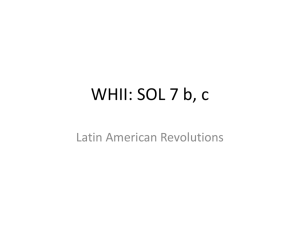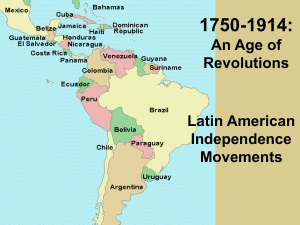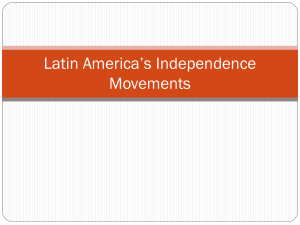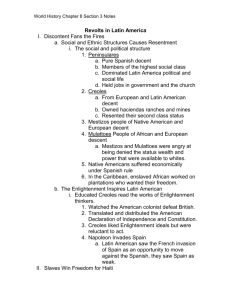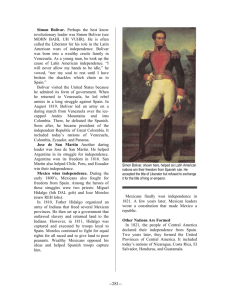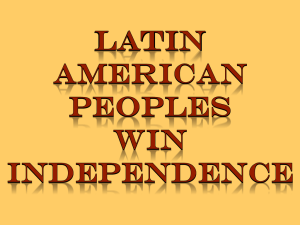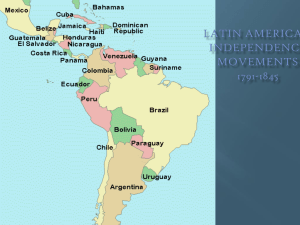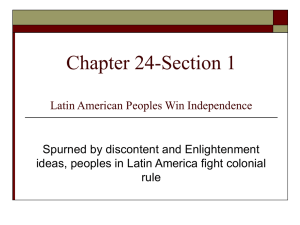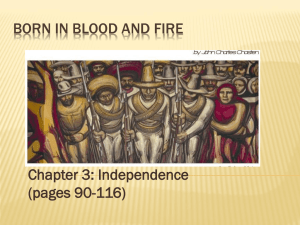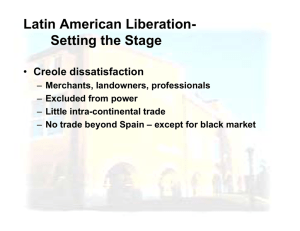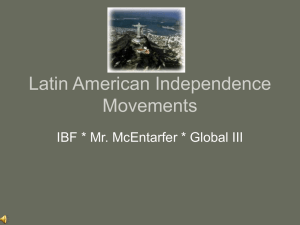Latin American Independence Background Toussaint L'Ouverture
advertisement
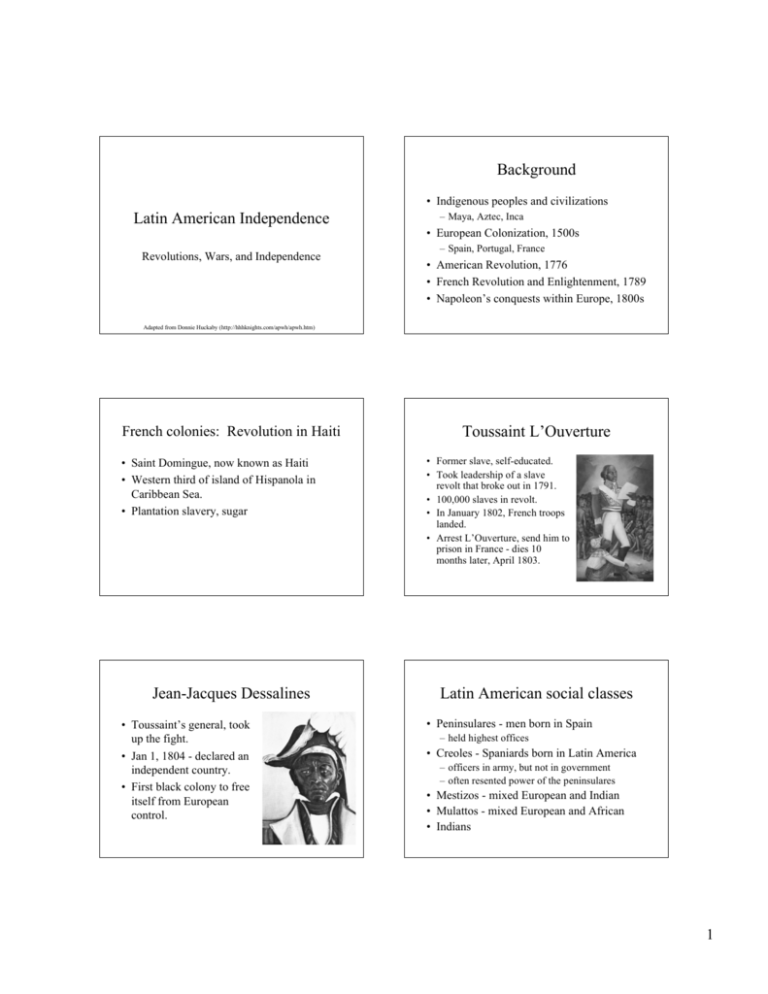
Background • Indigenous peoples and civilizations Latin American Independence Revolutions, Wars, and Independence – Maya, Aztec, Inca • European Colonization, 1500s – Spain, Portugal, France • American Revolution, 1776 • French Revolution and Enlightenment, 1789 • Napoleon’s conquests within Europe, 1800s Adapted from Donnie Huckaby (http://hhhknights.com/apwh/apwh.htm) French colonies: Revolution in Haiti • Saint Domingue, now known as Haiti • Western third of island of Hispanola in Caribbean Sea. • Plantation slavery, sugar Jean-Jacques Dessalines • Toussaint’s general, took up the fight. • Jan 1, 1804 - declared an independent country. • First black colony to free itself from European control. Toussaint L’Ouverture • Former slave, self-educated. • Took leadership of a slave revolt that broke out in 1791. • 100,000 slaves in revolt. • In January 1802, French troops landed. • Arrest L’Ouverture, send him to prison in France - dies 10 months later, April 1803. Latin American social classes • Peninsulares - men born in Spain – held highest offices • Creoles - Spaniards born in Latin America – officers in army, but not in government – often resented power of the peninsulares • Mestizos - mixed European and Indian • Mulattos - mixed European and African • Indians 1 European Background: Napoleon • Napoleon invaded Spain in 1808. • Removed Spain’s King Ferdinand VII and made Joseph (Nap’s brother) king of Spain. • Creoles used it as a reason for revolution. • 1810 rebellion across Latin America. • 1814, Napoleon defeated and Ferdinand returned to power, but creoles cont’d their movement. Simon Bolivar • Born a Creole in Venezuela • Influenced by Enlightenment thinkers through education and trips to Europe • Hoped to unite all of South America into one nation • Very capable general whose victories brought independence to Columbia, Venezuela, Peru, and Bolivia Gran Colombia, 1820-1830 • Bolivar’s vision of a united South America. • Present-day Colombia, Ecuador, Venezuela and Panama. • Short-lived due to dissension amongst various factions. • Bolivar resigned in 1828. • In 1830, Bolivar’s Gran Colombia divided into Colombia, Ecuador and Venezuela. Simon Bolivar • Wealthy Venezuelan creole. • “The Liberator” Jose de San Martin • Simple, modest man. • Born in Argentina, spent time in Spain as military officer. • San Martin led army to free Argentina, Peru • Ecuador, 1822: San Martin met with Bolivar to decide how to remove remaining Spanish forces in Lima, Peru. Mexico • Indians and mestizos, not creoles, played the key role in independence movements. • Two revolutionary leaders attempt to bring real change • Creoles sided with Spain to avoid violence of lower-class rebellions (until 1820). 2 Father Miguel Hidalgo • As a Creole, Father Miguel Hidalgo was in was part of a movement to gain independence • Hidalgo was far more progress then the others, he believed in social equality and wanted to help the Indians Father Jose Maria Morelos • Took leadership after Hidalgo’s death • Hoped to create an independent republic, eliminate power of Spaniards, Creoles, and Church • Evoked Mexican nationalism • Caught in 1815 and executed Father Miguel Hidalgo • In 1810, he led a mob army of 600 Indians to Mexico City that swelled to over 60,000 • Outside of the city, Hidalgo declared Mexican independence, abolished slavery • He disbanded mob before taking city, he was later arrested and executed by Spanish military in 1811 Mexican Independence, 1821 • 1820 revolution in Spain put a liberal government in power. • Mexican creoles feared loss of influence, so they united against Spain. • Agustin Iturbide declared himself emperor, but was overthrown. • 1824: Establishment of the Mexican Republic. • • Brazilian Independence In 1807, Napoleon marched on Iberian peninsula, forcing Portuguese royal family of King John VI to escape to Brazil, Portugal’s largest colony. From 1807 to 1815, Brazil was center of Portuguese empire. 3 Brazil • With defeat of Napoleon in 1815, Portugal wanted Brazil to become a colony again. • By 1822, creoles demanding independence signed a petition asking Portugal’s prince, Dom Pedro, to rule Brazil. • On Sept 7, 1822, Dom Pedro agreed, and declared Brazil’s independence Period of Consolidation, 1825-1850 • Breakdown of original nations and groups: – Gran Colombia – an original union between Bolivia and Peru – United Provinces of Central America • Instability of internal politics – Bolivia experienced 60 revolts and coups. – Venezuela experienced 52 revolts and coups Achievements • Expansion of education system, open new lands to settlement, abolish slavery. • Stability in foreign affairs - map fixed after 1850 – In 1820, Britain established Uruguay as a buffer between Argentina and Brazil – US provoked the only major changes • Mexican-American War, Cuba, Panama Brazil • Emperor Pedro I, to emulate Napoleon and to unify various elements of Brazil. • Pedro’s political and personal problems led to a decline in his popularity. • 1889, Brazilians overthrew Pedro’s successor and declared their country a republic. Period of Consolidation, 1825-1850 • Liberals - free trade, representative govt, federal government system • Conservatives - protect church and upper classes – controlled most regimes between 1830 and 1870. • Independence movements and new governments run by Creoles • Spanish administrators had excluded Creoles from political leadership, so few leaders could actually run a government. Results of Latin American Independence Movements • Political/Social: – Continued battles between liberals, conservatives and the military over how to best rule. – Tensions between articulate political forces and the separate masses. • Economic: – Unable to free itself from dependence on Westerncontrolled economic patterns. • Cultural/intelligent: – Distinct cultural entity • combination of Western styles and values plus its racial diversity, colonial past, and social structure of a semicolonial economy. 4
